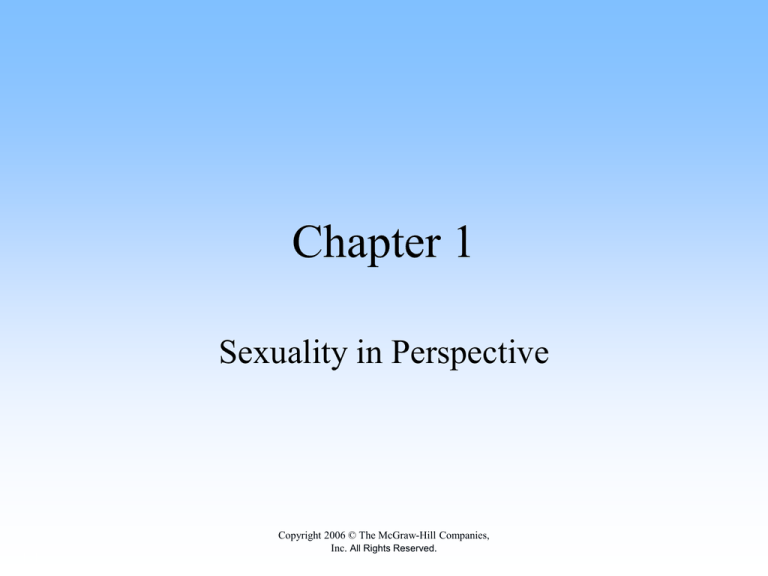
Chapter 1
Sexuality in Perspective
1-1
Copyright 2006 © The McGraw-Hill Companies,
Inc. All Rights Reserved.
Sex and Gender
• Sex refers to sexual anatomy and sexual
behavior.
• Gender refers to the state of being male or
female.
• Sexual behavior produces arousal and
increases the chance of orgasm.
1-2
Copyright 2006 © The McGraw-Hill Companies,
Inc. All Rights Reserved.
Cross-Species Perspectives on
Sexuality
• Human uniqueness - sexual behavior is
more instinctively controlled among
lower species & more controlled by the
brain in higher species.
• Nonsexual uses of sexual behavior animals sometimes use sexual behavior
for nonsexual purposes.
1-3
Copyright 2006 © The McGraw-Hill Companies,
Inc. All Rights Reserved.
Cross-Species Perspectives on
Sexuality
• Masturbation - found among many
species of mammals.
• Same-gender behavior - found in many
species.
• Sexual signaling - found in other
species.
• Bonobo Sex
1-4
Copyright 2006 © The McGraw-Hill Companies,
Inc. All Rights Reserved.
Understanding Sexuality: Religion
• Until about 100 years ago, religion provided
most of the information people had about
sexuality.
• People of different religions hold different
understandings of human sexuality.
• These religious views often have a profound
impact.
1-5
Copyright 2006 © The McGraw-Hill Companies,
Inc. All Rights Reserved.
Sex at Dawn
Sex at Dawn Theme
Having Sex Like a Caveman
How Darwin Can Save Your
Marriage
1-6
Copyright 2006 © The McGraw-Hill Companies,
Inc. All Rights Reserved.
Cross-Cultural
Perspectives on Sexuality
• Culture refers to traditional ideas and
values.
• Ethnocentrism influences our
understanding of human sexual behavior.
1-7
Copyright 2006 © The McGraw-Hill Companies,
Inc. All Rights Reserved.
Cross-Cultural Perspectives
on Sexuality
• Societies respond differently to:
– Kissing
– Inflicting pain
– Masturbation
– Premarital sex
– Extramarital sex
– Sex with same-gendered partners
1-8
Copyright 2006 © The McGraw-Hill Companies,
Inc. All Rights Reserved.
Cross-Cultural
Perspectives on Sexuality
• Incest taboos - regulations prohibiting sexual
interaction between blood relatives are nearly
universal.
• Most societies also condemn forced sexual
relations such as rape.
• Almost every society has a postpartum sex taboo.
• Different societies have different standards of
attractiveness.
1-9
Copyright 2006 © The McGraw-Hill Companies,
Inc. All Rights Reserved.
Significance of the
Cross-Cultural Studies
• Give us an understanding of the enormous
variation in human sexual behavior.
• Help us put our own standards and behavior
in perspective.
• Provide us with evidence concerning the
importance of culture and learning in the
shaping of sexual behavior.
1-10
Copyright 2006 © The McGraw-Hill Companies,
Inc. All Rights Reserved.
Bronfenbrenner’s Ecological Model
1-11
Understanding Sexuality: The Media
• Primetime TV programs average 10 instances of
sexual behavior per hour.
• Media has 3 types of influence:
– cultivation – people think what is portrayed really
represents what happens in our culture
– agenda-setting – reporters select what to report or
ignore and what to emphasize (necessitates that
professionals protect themselves from accusations)
– social learning – actors serve as models whom are
imitated
1-12
Copyright 2006 © The McGraw-Hill Companies,
Inc. All Rights Reserved.
Internet as a Media Form
• The Internet is the newest, perhaps most powerful,
mass media influence.
• 84% of homes in the USA with children have
Internet access.
• 28% of male and 3% of female adolescents report
once a week viewing of pictures of people having
sex.
• In 2010, 9% of youth between 10 and 17 had
received at least one sexual solicitation over the
Internet in the past year.
1-13
Copyright 2006 © The McGraw-Hill Companies,
Inc. All Rights Reserved.
Understanding Sexuality: Science
• Scientific study of sex began in the 19th century.
• Major breakthroughs in the scientific
understanding of sex came with the massive
surveys in the United States by Alfred Kinsey and
investigations by Masters and Johnson.
• The scientific study of sexuality has not emerged
as a separate academic discipline. It is a joint
effort by biologists, psychologists, sociologists,
anthropologists, & physicians.
1-14
Copyright 2006 © The McGraw-Hill Companies,
Inc. All Rights Reserved.
Important Sex Researchers
• Sigmund Freud – late 1800s, Victorian era –
theory emphasizes sexual tensions and conflict
• Henry Havelock Ellis – Physician in Victorian
England, viewed women as equally interested
in sex as men – believed sexual deviations
from the norm are often harmless and urged
society to accept them. Approach of collecting
information about human sexuality rather than
making judgments about it became a
forerunner of modern sex research
1-15
Copyright 2006 © The McGraw-Hill Companies,
Inc. All Rights Reserved.
Important Sex Researchers
• Richard von Krafft-Ebing – 19th Century
psychiatrist, collected >200 case histories of
pathological individuals, coined concepts of
sadism, masochism, and pedophelia, introduced
terms heterosexuality & homosexuality
• Magnus Hirschfeld – founded 1st sex research
institute & administered 1st large-scale sex survey
(130 questions) (n=10,000), established 1st journal
devoted to study of sex
1-16
Copyright 2006 © The McGraw-Hill Companies,
Inc. All Rights Reserved.
Victorian Sex Researcher
Clelia Mosher, M.D.
• Conducted sex survey of women over 30 yr
period
• Found they enjoyed sex with their husbands
• 80% said they felt a desire for sexual
intercourse
• 72% had experienced orgasm
• 64% used some form of birth control
1-17
Copyright 2006 © The McGraw-Hill Companies,
Inc. All Rights Reserved.
History of Sex Research
1-18
Sexuality Practice Varies by Social Class
1-19
Variations in Sexual Behaviors
Among Ethnic Groups
1-20
The Sexual Health Perspective
• Sexual health is a state of physical,
emotional, mental, and social well-being in
relation to sexuality
• For sexual health to be attained and
maintained, the sexual rights of all persons
must be respected, protected, and fulfilled
(World Health Organization 2002)
1-21
© 2014 by McGraw-Hill Education. This is proprietary material solely for authorized instructor use. Not authorized for sale or distribution in
any manner. This document may not be copied, scanned, duplicated, forwarded, distributed, or posted on a website, in whole or in part.



